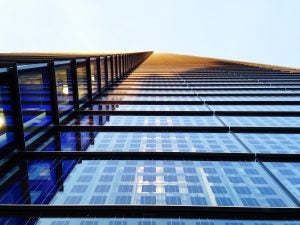 It’s no secret that companies use goals to push their businesses in a positive direction. Whether it’s about creating more value or reducing impacts, goals provide focus, direction, and a sense of urgency. Recently, a wave corporate, climate-related goals, such as renewable energy and emissions-reductions targets, have grabbed the public’s attention. Companies, cities, and other large institutions are stepping up and committing to reduce their environmental impact. But behind the scenes, are these goals actually leading to corporate action? And if so, what kind?
It’s no secret that companies use goals to push their businesses in a positive direction. Whether it’s about creating more value or reducing impacts, goals provide focus, direction, and a sense of urgency. Recently, a wave corporate, climate-related goals, such as renewable energy and emissions-reductions targets, have grabbed the public’s attention. Companies, cities, and other large institutions are stepping up and committing to reduce their environmental impact. But behind the scenes, are these goals actually leading to corporate action? And if so, what kind?
As program director of EDF Climate Corps, every summer I get a glimpse inside the operations of 100 large organizations that are working to manage energy and carbon in progressively responsible ways. This past summer, 125 EDF Climate Corps fellows – talented graduate students armed with training and expert support – worked to advance clean energy projects in large organizations across the U.S. and in China. Their project work reveals that organizations are more strategic, focused, and results-oriented than ever. More than 70 percent of EDF Climate Corps host organizations have energy or emissions-reductions goals, and to meet these targets, our class of 2016 fellows were strategically deployed to help achieve them. In fact, the majority (two-thirds) of our entire cohort of fellows worked on strategic plans and analyses that will help turn these goals into action. So what did we see this summer?
- Ambitious goals are driving big impacts at the building level
A great example of goals driving smart and strategic action in buildings is our recent work in New York City. Over the summer, more than 25 fellows worked within companies, city agencies, and even a local utility to design strategic plans to help meet Mayor de Blasio’s ambitious 80 x 50 goal that pledges to reduce city greenhouse gas emissions 80% by 2050. Rather than approach this one boiler room at a time, our fellows worked on ambitious, portfolio-wide equipment replacement and onsite renewable energy plans, with the potential to impact thousands of buildings at once. It’s great to see a municipal goal drive strategy from both the public and the private sector. The mayor’s goals are clearly spurring action, and large-scale strategy is the way to drive rapid improvements that could take much longer through an incremental approach.
- Public goals allow leaders to shine, but also inspire others to follow
Many corporations maintain internal sustainability goals, but shy away from publicizing them for a multitude of reasons, ranging from fears of greenwashing to competitive advantage. But we’ve recently observed that this trend is changing, with more and more of our host companies realizing that smart, data-driven analysis can help them set public commitments with confidence. For example, EDF Climate Corps host Amalgamated Bank wanted to incorporate climate change mitigation in its mission, but first needed to dig deeper into its data to create smart goals and a strategy to achieve them. With the help of their fellow, who conducted its first greenhouse gas emissions inventory and an assessment of its carbon footprint, Amalgamated Bank got the information it needed to set ambitious goals, culminating in an announcement in September to become the second largest net-zero energy bank.
[Tweet “Working Smarter, Not Harder: How Companies Are Setting New Energy Goals”]
- Supply chains are beginning to benefit from corporate goals
While many corporations have articulated impressive goals related to their corporate operations, setting targets in supply chains is an even more ambitious endeavor. Corporate supply chains are the source of significant carbon emissions and are notoriously hard to manage. Longtime EDF Climate Corps host Verizon – a corporation with a history of setting and achieving sustainability goals – knew that by working strategically it could tackle this daunting challenge. This past summer, Verizon asked its EDF Climate Corps fellow to help the company cross the finish line on its 2017 supplier target. By creating a holistic strategy that used a combination of risk-identification and supplier engagement, Verizon is now on track to accomplish its 2017 supplier goal and formally launch its next target to help manage supply chain carbon emissions.
The EDF Climate Corps community is a living laboratory. Through our fellowships and engagement with large energy users, we see companies and cities trying new things, and working smarter, not harder, to achieve ambitious goals. We’ve mirrored this journey as well, moving from a “one boiler room at a time” mentality to broader, more strategic engagement with companies to help drive progress. Through a focus on smart energy strategy, driven by goals, we know that companies can generate a virtuous cycle of positive returns for their organizations.
This post originally appeared on our EDF+Business blog.









